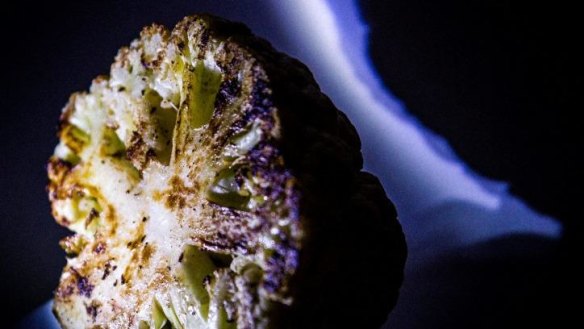How fermentation inspired Bryan Martin's roast cauliflower recipe

You know you are into new territory when you spend half an hour listening to two podcasters argue about kefir grains, mason jars and marijuana-laced kombucha. I'm a fairly keen fermenter and like having a certain amount of active biota in my larder and fridge but this lot seem a little obsessed with microbiological active foods.
I just bought a great book on this topic. If you are after loads of information about fermentation and haven't the bothersome time of becoming a mycologist or can't put up with vague podcasters, The Art of Fermentation, by Sandor Katz, is a pretty detailed journal on just about anything that is remotely fermentable and edible. So I am full of fermentation facts and figures.
One third of what the world eats is derived from fermentation, so it's not this thing that hipsters invented from having an epiphany after a particular good kimchi. It's a process that has not only given civilisation the ability to preserve food but also to make these foods more digestible and better for you.
There is an interesting point that Katz brings up, one that you may want to ponder over your breakfast. You and I are home to an amazing array of microbes. If they deserted you for some collective reason, life would be pretty grim. These bacteria, yeasts, fungi and their substrates make up roughly 10 times that of your DNA. So now you have something else to blame, besides pork fat, beer and Netflix, if your weight isn't what you want it to be.
Makes your skin crawl right? Well, particularly in the moister spots, more than it is already. Katz suggests that we are essentially an elaborate composite of many species.
We should be grateful for all this microbiological activity. The ancestors of these single-celled organisms created the world that we seem to enjoy living in. Before higher forms like Tony Abbott evolved, bacteria were it. These ancient forms increased the oxygen concentration to levels that could sustain life and also became part of us and now we are inextricably linked by this symbiotic relationship.
Fermentation is essentially an anaerobic metabolic process. In food terms, this process will convert carbohydrates to alcohols and/or acids that will then preserve the food. There are plenty of everyday examples to prove that we need fermentation in our lives. At the next dinner party, carefully decant and pour glasses of grape juice and ponder what is in the glass. Yeast and bacteria take this sweet and simple fruit juice and transform it into something wonderful. Now it's a beverage that you can spend huge bucks on and bore people near to death with.
Other everyday luxuries include beer, cheese and coffee. Even though you can probably live life fully without these products of fermentation, I'm sure it would be less fun and generally these all do have health benefits.
So, am I ready to ditch the fridge and swap it for a room full of crocks, jars and gourds? Not quite, but this book does give you food for thought as to how many foods are possible with some active bacteria and time.
Recently, I was lunching in Melbourne at a little restaurant in Carlton. Town Mouse it was called and among all the shared plates we enjoying was this pretty neat roast cauliflower and miso dish. They ferment their own broad bean miso, and this intense, salty dressing went so well with the nuttiness of the roast almonds and cauliflower itself. It had a great texture, soft yet still crunchy and set off with the sharpness of chives.
Unfortunately, if you make your own miso this will take about eight months to prepare, so I looked around for another strong, fermented condiment to substitute. Black garlic came up; the long slow process gives an intense flavour of molasses, tamarind and Worcestershire sauce. Bredbo black garlic is available at the regional markets and switched-on food purveyors like The Essential Ingredient and the Ainslie IGA. It's a worthy substitute, while your miso ferment bubbles away in your crock.
Roast cauliflower with almonds and black garlic butter
1 head of cauliflower
100g unsalted butter plus extra for baking, at room temperature
1 bulb of Bredbo black garlic
½ cup blanched almonds, chopped
chives
salt and pepper
Heat the oven up to 200C. Cut the cauliflower in half, or quarters if it's a big one. In an oven-proof frying pan, heat the extra butter and saute the cut side of the cauliflower. Cook just a little to start the roasting process. Bake in the oven for 20 minutes.
Meanwhile, break apart the garlic bulb and extract all the black, sticky cloves. Mash these with a fork and a pinch of salt and then continue by mashing this into the butter until it looks uniform. You can do this ahead of time and it will keep for a week or so.
Once the cauliflower is cooked, take out of the oven and remove from the frying pan and keep warm on a serving plate. Add the almonds and cook over a low heat until they start to brown up. Off the heat, stir into this the prepared garlic butter so that it gently melts, pour over the cauliflower and garnish with chopped chives and a grind of pepper.
The best recipes from Australia's leading chefs straight to your inbox.
Sign up